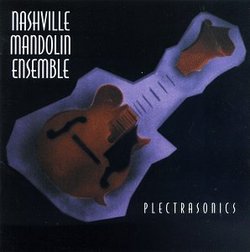Amazon.comBecause Bill Monroe played the mandolin, the instrument has become inseparably linked to bluegrass in our minds. Yet the mandolin has a long and glorious history that goes back to the 1700s, when it first emerged as a variation of the lute and inspired Vivaldi and Mozart to write music for it. It became a staple of Italian and Spanish folk music, and on New Year's Day, 1880, the Figaro Spanish Students arrived by boat in New York and kicked off a mandolin craze which swept the nation. Mandolin clubs formed where 4-11 musicians would play intricate arrangements on mandolins, mandolas, mandocellos, double bass and guitar. By the 1920s, the fad had died out, and junk stores were full of discarded mandolins. The instrument only survived in such rural recesses as Rosine, Kentucky, where Monroe grew up. Monroe inspired a thousand mandolin careers, and many of his heirs grew curious about the instrument's neglected history. Out of that curiosity came the Nashville Mandolin Ensemble, which has recreated the sound of the turn-of-the-century mandolin clubs. Like those earlier clubs, the NME has plundered all areas of contemporary music for material to arrange for seven mandolins, bass and guitar. Thus the group's first album, Plectrasonics, includes Monroe's "My Last Days on Earth," the Beatles' "Because," Django Reinhardt's "Tears," Charles Mingus' "Goodbye Pork-Pie Hat," the modern classical piece "Cuban Landscape with Rain" and "The Theme from Star Trek" (aka "Where No Mandolin Has Gone Before"). These familiar tunes sound completely, marvelously different in the hands of the NME. It often sounds as if the listener were trapped inside a giant music box with some gears clicking along at quarter notes, others at eighth notes, and still others at 16th or 32nd notes.--Geoffrey Himes


 Track Listings (12) - Disc #1
Track Listings (12) - Disc #1